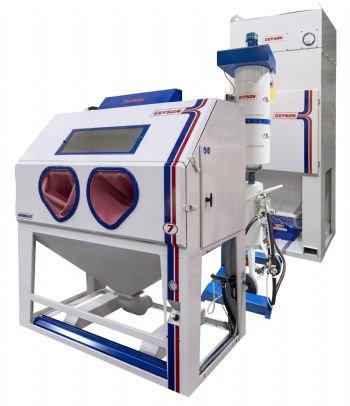
North Yorkshire
Guyson International, a leading manufacturer of industrial finishing equipment, has recently delivered its latest Guyson Euroblast 7PF ‘Pressure Fed’ manually-operated blast cabinet into a tool coating company for reclaiming expensive vacuum coating shields used in the Physical Vapour Deposition (PVD) coating process.
The Euroblast size 7 cabinet is popular with many of the world’s leading cutting tool coating companies for this application. Using physical vapour deposition, a base component (cutting tools such as drills, cutting hobs and end-mills) is covered with a hard-wearing or heat-resistant material such as Titanium Nitride (TiN), Titanium CarboNitride (TiCN), Aluminium Titanium Nitride (AlTiN) or TiAlN (Titanium Aluminum Nitride) to extend the products performance capabilities.
PVD is a line-of-sight coating process that produces thin coatings and sharp edges and is done either by thermal evaporation or by sputtering. The sputtering process is a more energy-efficient and flexible method of coating, with a wider range of materials (such as alloys) while ensuring better surface adhesion and uniformity.
During the PVD process, which is performed in a vacuum chamber, the coating is not only applied to the product itself but also coats the internal walls and windows of the chamber with an overspray of thin-film coating which can be difficult to remove, especially in situ.
Therefore, most chambers are equipped with internal shields that protect the walls and windows etc. However, over time, these shields also become heavily coated and develop a multi-coloured pattern on them and the surface coating can start to fragment and crack, which can then start to negatively impact the PVD coating process unless they are cleaned.
Popular choiceThe Euroblast 7PF blast cabinet is a popular choice for cleaning up these shields due to its wide cabinet size allowing it to accommodate a larger number of shields, usually up to a maximum size of 30 cm x 20 cm. Importantly, the larger armholes allow the operator to reach the full shield edges from a standing position.
Furthermore, it is designed to offer exceptional component access, with doors opening from the front, top and side, making it easy to load components into a blast chamber with dimensions of 1,480 x 900 x 880mm . It is also available with an optional fixed-position turntable (750mm diameter, 150kg load capacity) and a flush-fitting internal floor so parts can be rotated easily to achieve full coverage.
Euroblast cabinets above the model 6 are equipped as standard with large armhole sleeves allowing for greater operator reach and a full-width foot pedal for blast gun operation with either foot. An adjustable gun support arm enables the operator to put the blast gun in the holder which then leaves both hands free to manipulate the component under the blast stream. Parts can then be cleaned down with the trigger operated airwash gun for post-blast removal of residual media/dust.
Guyson offers two types of pressure pots — 55-litre and 27-litre — depending on the intended blast cycle and the volume of components, to generate the blast stream within the blast chamber. As soon as the foot pedal is pressed, it lets pressure into the pot and initiates the blasting process through a heavy-duty hose to the blast nozzle; similarly, releasing the pedal will release the pressure from the pot and stop the process.
Guyson recommends a cyclone reclamator to separate re-usable media from the dust, blast debris, and undersized media in their pressure fed blast systems. It does this by extracting everything from the bottom of the blast cabinet, with the lighter particulates drawn off to the dust collector, while the heavier re-usable blast media returns to the pressure pot. This reduces the chances of contamination from abraded particles and debris in the media, which could affect the consistency of the finish.
The entire system is completed with a Guyson dust collector, matched to the pressure pot and blast cabinet size for collecting dust-laden air from the blast cabinet. The heavier extracted particles are deflected downward towards the collection bin, and the lighter ones are captured on the filter surface. The heavy-duty perforated steel floor of the blast cabinet traps larger pieces of debris, while a secondary perforated steel floor in the hopper traps smaller pieces, thus reducing blockages in the blast hose/blast gun.